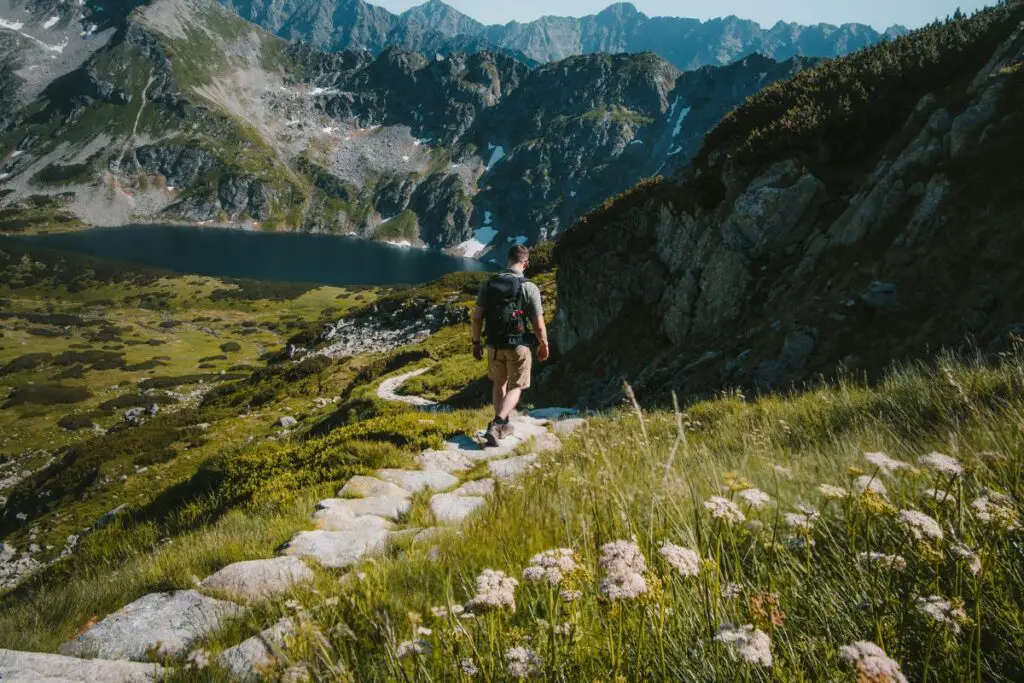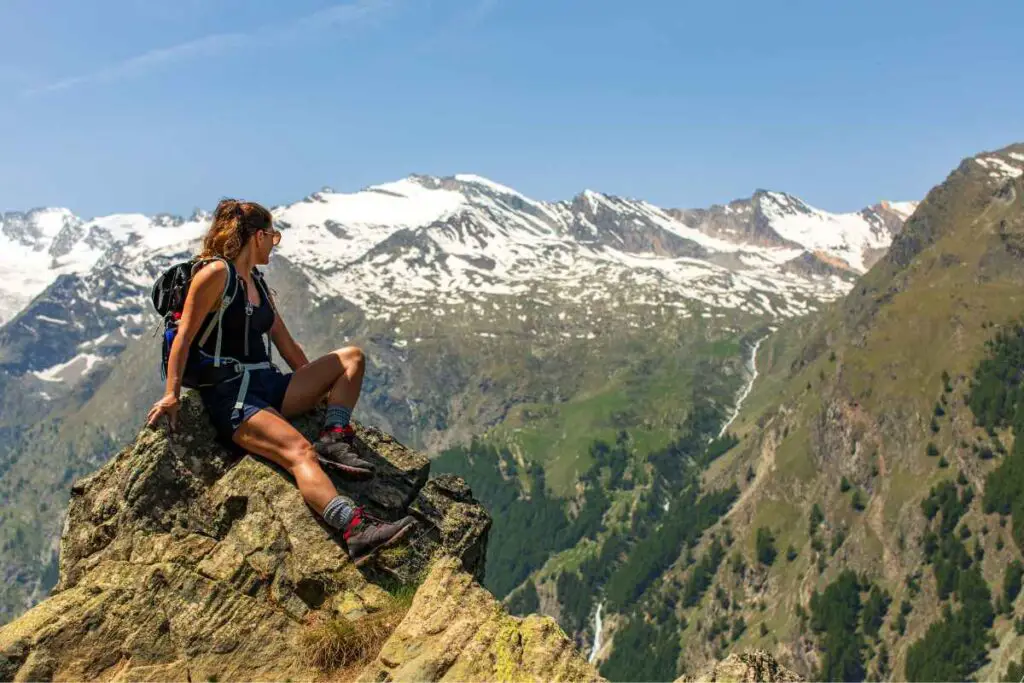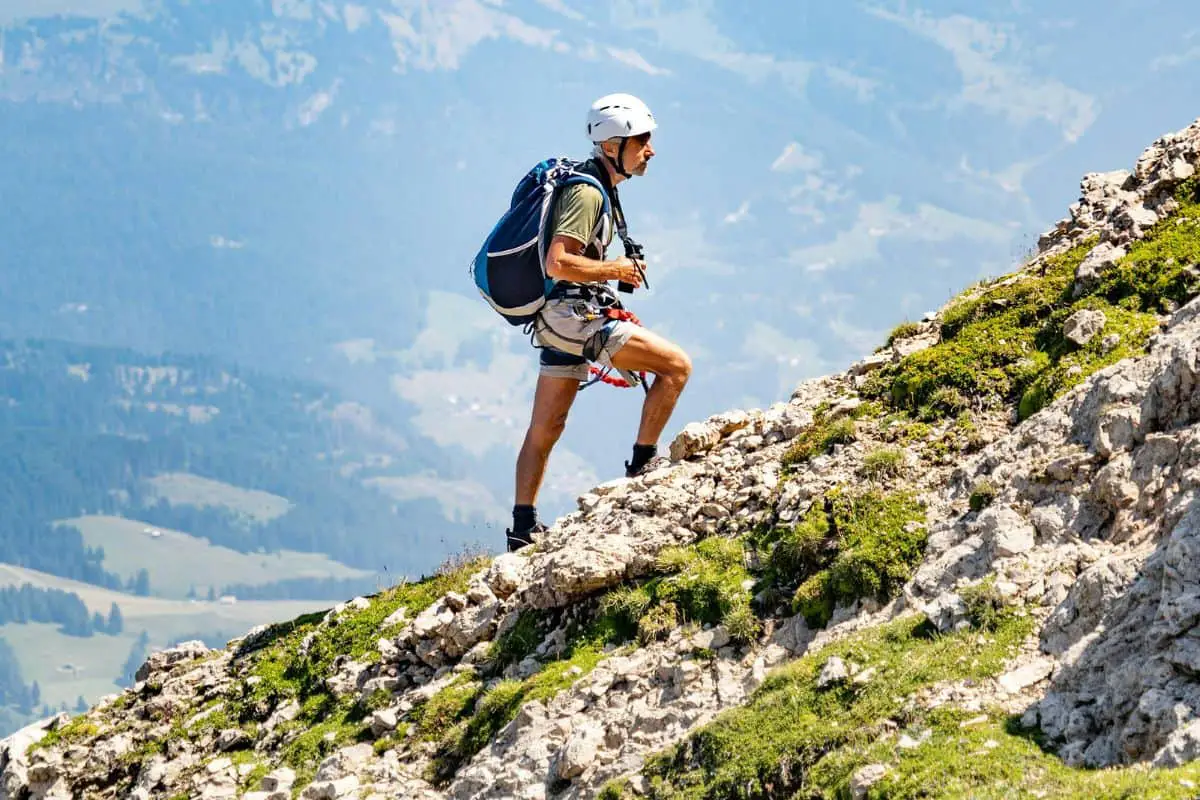A question many of us will inevitably ask at some point – How to strengthen knees for hiking?
To get started:
- Focus on exercises that bolster your quadriceps, hamstrings, calves, and hip abductors. These muscles are key players in supporting knee movements.
- Leg lifts, for instance, can strengthen the quadriceps without adding unnecessary pressure to your knees.
- Squats and lunges are also effective, as they simulate the action of ascending and descending hills.
These exercises not only build muscle around the knees but also promote overall leg strength, which is beneficial for tackling long and challenging treks.

Incorporating stretching routines into your exercise regimen is equally important for knee health. Flexibility aids in preventing muscle imbalances and ensures that joints move through their full range of motion.
By preparing your knees for hiking through a combination of strength training and flexibility exercises, you’ll be better equipped to handle the physical demands of the trails while minimizing the risk of injury.
Understanding Knee Anatomy and Common Issues
When hiking, it’s crucial to have a solid understanding of your knee’s anatomy and the common issues that can arise.
A well-informed approach can help you prepare for and prevent potential knee injuries.
- EXCLUSIVE PATENT— Spring knee support technology: An anatomically contoured patella gel pad surrounds your kneecap, double-sided spring stabilizers fit tightly with your knee joint. These special functional element strengthen side support and maintains joint stability. It effectively disperses knee pressure, keeping your knee warm, lubricating your joints, so it will prevent potential sports injuries without sacrificing your performance! BEST CHOICE for sports protection and knee pain relief.
- TARGETED PAIN RELIEF— Innovative functional fabric has the effect of keep knee warm and reduce stiffness, reducing inflammation and swelling, speed oxygen flow. This knee brace disperse the pressure and improves circulation around knee area, wrap around your patella to enhance the stability of kneecap and relax tendons, avoid pulling, prevent muscle strain. Relieve ACL, MCL, PCL pain, prevent ligament injury, meniscus tear, swelling, inflammation and so on. FDA Registered — Doctor Recommand!
- UPGRADED DESIGN— Adopt the Anti-Inflammatory Therapy, overcome the defects of similar products, medical knee sleeves with no allergies and itchiness. With high-elastic tight and breathable compression fabric to fit perfectly with your knee curve, 3D structure of woven, high-precision knitting cutting technology. Side spring stabilizers on both sides and patella gel pad won't fall off easily during using, Non-slip gel strips to avoid slide or roll during exercise, It will stay in place all day!
- INNOVATIVE TECHNOLOGY— It works by applying targeted compression to your knee, which help joint and muscle pain relief and faster recovery after intense workouts or injuries, scientifically proven to help improve poor blood circulation & increase oxygen flow to optimize the natural healing process, and reduce inflammation for knee pain relief from acute or chronic joint injuries. Braces & Splints - It is Perfect for Pain Recovery or Workout!
- BETTER PERFORMANCE— We got a well balance between compression and comfort, premium knee sleeve will apply even compression to your joint, which will significantly relief knee pain. The air knit fabric can instantly absorb and evaporate lots of sweat, circular breathing. Breathable, fast-dry and lightweight. You can wear it under jeans or leggings and sleep with it, thicker than other knee protectors to provide extra reinforcement without sacrificing comfort, so you can wear them all day long!
Components of the Knee Joint
Your knee is a complex joint that relies on several structures for smooth operation.
The bones involved include the femur (thigh bone), tibia (shin bone), and the patella (kneecap). These bones are connected by ligaments, which are tough bands of tissue that stabilize your knee.
Tendons connect muscles to the bones, facilitating movement. Inside the joint, cartilage provides cushioning between the bones, while synovial fluid lubricates the joint to reduce friction.
- Ligaments in the knee:
- Anterior cruciate ligament (ACL)
- Posterior cruciate ligament (PCL)
- Medial collateral ligament (MCL)
- Lateral collateral ligament (LCL)
- Tendons in the knee:
- Patellar tendon
- Cartilage:
- Menisci (medial and lateral)
- Articular cartilage

Common Knee Injuries and Strains
When hiking, you might experience knee pain due to various injuries or strains. The common issues include ligament sprains, tendonitis, and cartilage tears.
Patellofemoral pain syndrome—pain around the front of the knee—is also a frequent complaint, often linked to increased activity.
Key injuries are often related to overuse or improper technique during physical activities:
- Ligament sprains (ACL/MCL injuries)
- Meniscal tears
- Tendonitis (such as jumper’s knee)
- Patellofemoral pain syndrome
Understanding these conditions can help in recognizing early symptoms and seeking prompt intervention to ensure a swift return to your hiking adventures.
Remember to always treat your knees with care to avoid complications that can come from overexerting these critical joints.

Essential Knee-Strengthening Exercises
Strong knees are crucial for hiking. You need muscle strength to support your joints and flexibility to maintain a full range of motion. Below are targeted exercises that focus on these two key areas.
Exercises to Build Muscle Strength
Building muscle strength around your knees is fundamental to support and protect the joint during hiking activities.
Here are some specific exercises designed to strengthen the quadriceps, hamstrings, calves, and the muscles around the knee:
- Squats:
- Stand with your feet shoulder-width apart.
- Lower your body as if sitting back into a chair until your thighs are parallel to the floor.
- Keep your knees over your ankles and your chest up.
- Return to the starting position.
- Lunges:
- Step forward with one leg and lower your hips until both knees are bent at about a 90-degree angle.
- Keep your front knee directly above your ankle.
- Push back to the starting position and repeat on the other side.
- Hamstring Curls:
- Stand facing a wall, using your hands for balance.
- Bend one knee to bring your heel toward your buttocks.
- Hold for a moment, then lower your foot to the ground.
- Repeat on the other side.
- Wall Sits:
- Stand with your back against a wall, walk your feet out slightly.
- Slide down the wall until your knees are at 90 degrees.
- Hold this position as long as you can.
- Straight Leg Lifts:
- Lie on your back with one leg bent and the other straight.
- Lift the straight leg about six inches off the ground.
- Hold for a few seconds, then lower back down.
- Step-Ups:
- Place one foot on a step or platform.
- Step up, bringing your other foot up to the step.
- Step down and repeat, then switch legs.
Stretching for Flexibility and Health

Flexibility is key for a well-rounded knee-strengthening routine. Stretching helps maintain joint health and prevent injuries.
Include these stretches to ensure your knees stay flexible:
- Calf Stretches:
- Stand facing a wall with your hands on the wall at about chest level.
- Move one leg back with your foot flat on the floor and bend the front knee.
- Hold the stretch for 30 seconds, then switch legs.
- Hamstring Stretches:
- Sit on the ground with your legs extended in front of you.
- Bend forward at your hips towards your toes while keeping your back straight.
- Hold for 15 to 30 seconds.
- Glute Bridges:
- Lie on your back with your knees bent and feet flat on the ground.
- Lift your hips to form a straight line from your knees to shoulders.
- Hold for a few seconds, then lower back down.
- Side Leg Lifts:
- Lie on your side with legs stacked and straight.
- Lift the top leg up while keeping it straight, then lower it slowly.
- Repeat several times before switching to the other side.
Incorporating these exercises into your routine will help enhance knee strength, promote stability, and reduce the risk of injury on the trails.
Proper Gear and Techniques for Hiking
To maximize knee support and stability when hiking, selecting the right gear and adopting proper hiking techniques are crucial.
The correct footwear and use of trekking poles can make a significant difference in your hiking experience.
Choosing Appropriate Footwear
- Hiking Boots: Ensure you select hiking boots that offer robust ankle support to stabilize your footing on uneven trails. Look for boots with cushioned soles to absorb impact and a snug fit to prevent unnecessary movement within the shoe.
| Features | Benefits |
|---|---|
| Ankle height | Provides additional support |
| Sturdy soles | Aids in weight distribution |
| Water resistance | Keeps feet dry and comfortable |
| Breathable material | Reduces moisture and blisters |
- Hiking Shoes: For less rugged terrain or day hikes, lightweight hiking shoes are appropriate. They offer comfort and flexibility without the added weight of boots.
- ADJUSTABLE STRAP can make adjustment according personal knee’s curves to supply better protection of patella; It is fully adjustable, fit 13 to 18 inches (Knee Circumference).
- HIGH QUALITY & DURABLE - This Knee Strap is made up of high-quality materials which gives it longer life and makes it durable.
- COMFORTABLE - Bodyprox Knee support strap provides patellar support with build in silicone gel padding for comfort. The soft neoprene strap are adjustable with hook-and-loop fastener straps and are very comfortable to wear. The padding provides good support for the knee especially when you're walking up or down an incline.
- RELIEF FROM KNEE PAIN-Bodyprox Knee strap is designed for knee pain & stiffness, arthritis, menisci and cartilage damage, patellar tendonitis and bursitis, torn ligaments and tendons, and even soft tissue and sport-related injuries.
- BREATHABLE! Reinforced with hexagonal venting holes for better ventilation providing ultimate comfort while stabilizing the knee and keeping away from any potential knee injury.
Using Trekking Poles for Stability
- Weight Distribution: Trekking poles can assist with distributing the load more evenly across your body, lessening the strain on your knees, especially when carrying a heavier pack.
- Proper Hiking Technique: When hiking uphill, adjust the length of your poles so your arms are at a 90-degree angle for optimal leverage. For downhill hiking, lengthen the poles to reach the ground comfortably. Keep your knees slightly bent and stand straight with a slight forward lean to prevent jarring.
- Pace: Using trekking poles can help you establish and maintain a steady pace, reducing the risk of injury by avoiding sudden movements or overextension of your knees.
By focusing on these factors, you can protect your knees and enhance your overall hiking experience.







